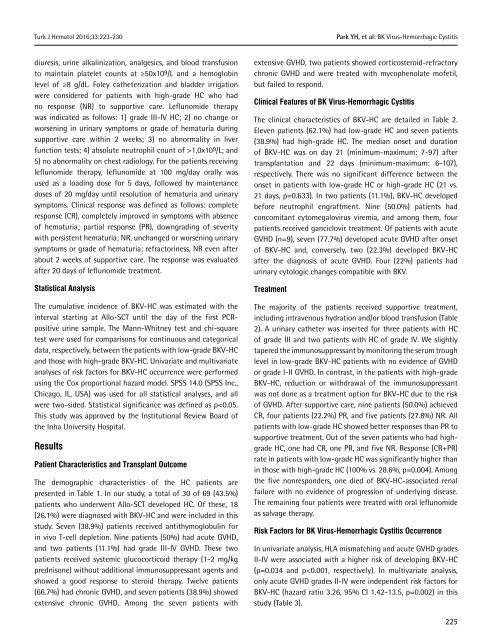Turkish Journal of Hematology Volume: 33 - Issue: 3
Create successful ePaper yourself
Turn your PDF publications into a flip-book with our unique Google optimized e-Paper software.
Turk J Hematol 2016;<strong>33</strong>:223-230<br />
Park YH, et al: BK Virus-Hemorrhagic Cystitis<br />
diuresis, urine alkalinization, analgesics, and blood transfusion<br />
to maintain platelet counts at ≥50x109/L and a hemoglobin<br />
level <strong>of</strong> ≥8 g/dL. Foley catheterization and bladder irrigation<br />
were considered for patients with high-grade HC who had<br />
no response (NR) to supportive care. Leflunomide therapy<br />
was indicated as follows: 1) grade III-IV HC; 2) no change or<br />
worsening in urinary symptoms or grade <strong>of</strong> hematuria during<br />
supportive care within 2 weeks; 3) no abnormality in liver<br />
function tests; 4) absolute neutrophil count <strong>of</strong> >1.0x109/L; and<br />
5) no abnormality on chest radiology. For the patients receiving<br />
leflunomide therapy, leflunomide at 100 mg/day orally was<br />
used as a loading dose for 5 days, followed by maintenance<br />
doses <strong>of</strong> 20 mg/day until resolution <strong>of</strong> hematuria and urinary<br />
symptoms. Clinical response was defined as follows: complete<br />
response (CR), completely improved in symptoms with absence<br />
<strong>of</strong> hematuria; partial response (PR), downgrading <strong>of</strong> severity<br />
with persistent hematuria; NR, unchanged or worsening urinary<br />
symptoms or grade <strong>of</strong> hematuria; refractoriness, NR even after<br />
about 2 weeks <strong>of</strong> supportive care. The response was evaluated<br />
after 20 days <strong>of</strong> leflunomide treatment.<br />
Statistical Analysis<br />
The cumulative incidence <strong>of</strong> BKV-HC was estimated with the<br />
interval starting at Allo-SCT until the day <strong>of</strong> the first PCRpositive<br />
urine sample. The Mann-Whitney test and chi-square<br />
test were used for comparisons for continuous and categorical<br />
data, respectively, between the patients with low-grade BKV-HC<br />
and those with high-grade BKV-HC. Univariate and multivariate<br />
analyses <strong>of</strong> risk factors for BKV-HC occurrence were performed<br />
using the Cox proportional hazard model. SPSS 14.0 (SPSS Inc.,<br />
Chicago, IL, USA) was used for all statistical analyses, and all<br />
were two-sided. Statistical significance was defined as p

















